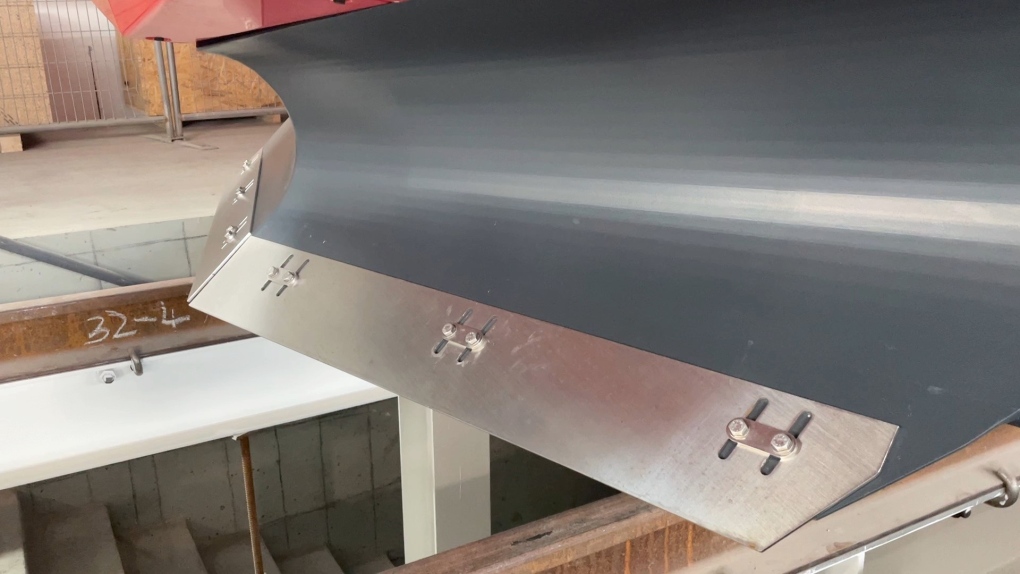Ottawa unveils its new Stadler FLIRT O-Train vehicles
Trains are being tested and work continues on completing the stations for Stage 2 of Ottawa's light rail transit project.
On Friday, the city of Ottawa provided a sneak peak on the trains to be used on the north-south Trillium Line.
"I’m please that to date the testing has gone very well on a four kilometre track here in the south end," Mayor Jim Watson said.
The new trains run on diesel and will travel from Bayview Station in Hintonburg to Riverside South, with a spur to the Ottawa International Airport. The trains are 80 metres long.
"A lot of room inside. It’s going to double the capacity over the existing line to 420 (passengers) on this one," says Coun. Allan Hubley. "The cabin where the driver is has better air ventilation in there. They showed us that the windows are heated. So in Ottawa winters it will run well and the driver will have good visibility."
Good visibility in the winter, and clean rails, since this train also comes equipped with a snow plow up front.
 The new Stadler FLIRT vehicle includes a snow plow. The city of Ottawa purchased seven trains as part of the Stage 2 LRT project. (Dave Charbonneau/CTV News Ottawa)
The new Stadler FLIRT vehicle includes a snow plow. The city of Ottawa purchased seven trains as part of the Stage 2 LRT project. (Dave Charbonneau/CTV News Ottawa)
"We have the propulsion system," says Stefan Baer, Stadler C.O.O. "We have four times diesel motors connected to a generator."
The Trillium Line is part of Ottawa’s stage 2 LRT project. The $4.6 billion project also includes running the Confederation Line to Trim Road in the east and Moodie Drive in the west.
However, the recent troubles of the Confederation Line have tested the trust in Ottawa’s LRT system.
"With all the troubles we had with the first one I don’t think it’s exciting," says transit user Faith Ordu. "I am skeptical. A little bit of optimism to see if things are going to work but more skeptical than optimistic."
Ottawa purchased seven, four-car multiple units from manufacturer Stadler.
The new timeline has the Trillium Line ready for passengers next spring at the earliest.
CTVNews.ca Top Stories

DEVELOPING Man sets self on fire outside New York court where Trump trial underway
A man set himself on fire on Friday outside the New York courthouse where Donald Trump's historic hush-money trial was taking place as jury selection wrapped up, but officials said he did not appear to have been targeting Trump.
BREAKING Sask. father found guilty of withholding daughter to prevent her from getting COVID-19 vaccine
Michael Gordon Jackson, a Saskatchewan man accused of abducting his daughter to prevent her from getting a COVID-19 vaccine, has been found guilty for contravention of a custody order.
She set out to find a husband in a year. Then she matched with a guy on a dating app on the other side of the world
Scottish comedian Samantha Hannah was working on a comedy show about finding a husband when Toby Hunter came into her life. What happened next surprised them both.
Mandisa, Grammy award-winning 'American Idol' alum, dead at 47
Soulful gospel artist Mandisa, a Grammy-winning singer who got her start as a contestant on 'American Idol' in 2006, has died, according to a statement on her verified social media. She was 47.
'It could be catastrophic': Woman says natural supplement contained hidden painkiller drug
A Manitoba woman thought she found a miracle natural supplement, but said a hidden ingredient wreaked havoc on her health.
Young people 'tortured' if stolen vehicle operations fail, Montreal police tell MPs
One day after a Montreal police officer fired gunshots at a suspect in a stolen vehicle, senior officers were telling parliamentarians that organized crime groups are recruiting people as young as 15 in the city to steal cars so that they can be shipped overseas.
The Body Shop Canada explores sale as demand outpaces inventory: court filing
The Body Shop Canada is exploring a sale as it struggles to get its hands on enough inventory to keep up with "robust" sales after announcing it would file for creditor protection and close 33 stores.
Vicious attack on a dog ends with charges for northern Ont. suspect
Police in Sault Ste. Marie charged a 22-year-old man with animal cruelty following an attack on a dog Thursday morning.
On federal budget, Macklem says 'fiscal track has not changed significantly'
Bank of Canada governor Tiff Macklem says Canada's fiscal position has 'not changed significantly' following the release of the federal government's budget.
































